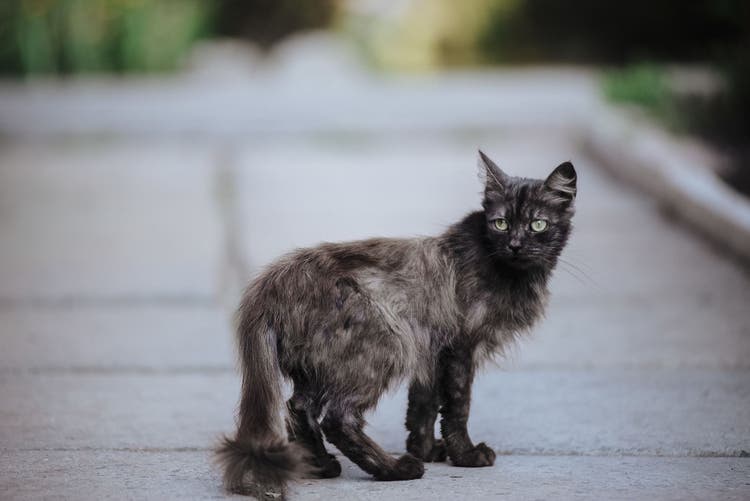
What Is a Feral Cat?
What is a feral cat? A feral cat is a cat that has had little to no contact with humans. They are usually unapproachable by people. These cats have been born into or adapted to outdoor life without human contact, living together in loose families organized as colonies. They hunt wildlife as food, including mice, birds, and lizards. These cats are not socialized enough to be handled by humans, and for that reason, they cannot easily be placed into a traditional pet home – if at all.
If you are wondering what is a feral cat, you should know that these cats cannot become loving companions – and most will never relish human companionship. They tend to stay away from humans. They hide during the day. Feral cats will find it difficult or impossible to adapt to living as pets in close contact with people. If you adopt a feral cat, you will find that it is very difficult to socialize.
Cats roam outside in most neighborhoods in the United States. Many of these cats are community cats that may be feral. According to the People for Ethical Treatment of Animals, it is estimated that there are between 60 million and 100 million feral cats living in the United States. The Humane Society estimates the number of outdoor cats at about 30 to 40 million. These cats are most often the offspring of cats who were lost or abandoned by their owners and they are not socialized to humans.
Community cats typically live in a colony that occupies and defends a specific territory where food and shelter are available. They may live near a restaurant dumpster, under a porch or in an abandoned building. But if these cats are feral, you will rarely see them because they hide from humans.
How to Help a Feral Cat
If you can’t adopt a feral cat, what can you do to help? Many experts believe that the best way to help our feral cat populations is through neutering programs that will reduce their numbers.
A female cat can become pregnant as early as 5 months of age. That one cat can have two or three litters of kittens a year. In seven years time, a single female cat and her kittens can produce 420,000 more cats. And as the feral cat population grows, so do the problems that are associated with it. So the feral cat population in a neighborhood can rapidly increase if cats are not spayed and neutered.
That’s why so many people including the ASPCA and the Humane Society believe that the best way to help feral cat colonies is through Trap-Neuter-Return (TNR) efforts. TNR is a nonlethal strategy for reducing the number of community cats and improving the quality of life for cats, wildlife and people. By catching these feral cats and neutering or spaying them, we can help to reduce the number of unwanted cats. Through TNR efforts, these feral cats will be humanely trapped, examined, vaccinated and surgically sterilized by veterinarians. The tip of one ear is surgically removed as a universally recognized sign that the feral cat has been spayed or neutered. Then the cat is returned to its home environment. These cats will no longer reproduce or fight over mates, and their nuisance behaviors are greatly reduced or eliminated.
Afterward, volunteers may provide food and shelter and monitor the health of these cats. Once neutered, these cats tend to gain weight and have fewer health issues. And with fewer females in heat, fewer tom cats are attracted to the area, meaning fewer risky catfights.
While many people advocate for TNR, others believe it is best to relocate feral cats or to put them down. Relocation is not an effective solution. Feral cat colonies are established in areas where resources like food, water, and shelter are available. If you move a feral colony, it won’t be long before another colony moves into this prime real estate and take its place. Also, a relocated cat may try to find its way home, perhaps suffering an accident or death along the way.
If you’re thinking about adopting a feral cat, think again. Feral adult cats are wild animals that simply cannot be tamed. You should never try to handle or pick up a feral cat. However, feral kittens that are under the age of eight weeks old can often be socialized and introduced into a human home.
So, what can we do to help feral cats?
Contact your local Humane Society to see if they have a TNR program. If they don’t, they may know of a local program they can refer you to. A little cash donation to these programs will go a long way toward helping feral cats. Shelters can perform a spay or neuter surgery for under $20. So a small donation on your part can really help. These programs are usually run by volunteers, so get involved and donate your time. There are many ways that you can help.
Within a managed colony, feral cats can live a long, happy life. You may also want to consider becoming a feral colony caretaker. In this role, you would provide food, shelter and healthcare to the cat colony. This is a big commitment because the feral cats in the community will grow to become dependent upon you. So if you move or go away on vacation you must find someone else to care for the cats while you are gone.
Before feeding a feral cat, find out if there are any laws or ordinances in your area that would prevent you from feeding stray or feral cats. Many areas do have such ordinances, and if you feed these cats you could incur a fine or other punishment.
To learn more about feral cats, go to the Care of Feral Cats.
To learn more about stray cats, read the article Surprise Visitors: What to Do With a Stray Cat.